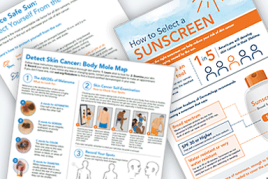May is Skin Cancer Awareness Month
What is Skin Cancer Awareness Month?
Occurring every May, Skin Cancer Awareness Month is 31 days devoted to shining the spotlight on:
How to prevent skin cancer
How to find skin cancer early when it's highly treatable
The fact that people of all skin tones develop skin cancer
Why is Skin Cancer Awareness Month important?
It's estimated that every day about 9,500 people in the United States are diagnosed with skin cancer. 1
Many of these skin cancers could be prevented if people would protect their skin from the sun and stop using tanning beds.

What is Melanoma Monday®?
A part of Skin Cancer Awareness Month, Melanoma Monday is a national day of awareness devoted to:
Educating people about melanoma, the most serious skin cancer
Preventing melanoma
Helping people find melanoma early through skin self-exams and free skin cancer checks
The American Academy of Dermatology (AAD) launched Melanoma Monday on Monday, May 1, 19952 and has observed it every year since. Melanoma Monday occurs during Skin Cancer Awareness Month on the first Monday in May.
This year, Melanoma Monday is Monday, May 5, 2025.
Why is Melanoma Monday important?
Melanoma is the most serious type of skin cancer. In 2025, it's estimated that about 104,960 melanomas will be diagnosed and around 8,430 people will die of melanoma.3

The AAD encourages everyone to begin a lifelong habit of checking their skin by performing skin self-exams. Here's why these exams are so important:
If caught early, melanoma is highly treatable.
Melanoma can develop anywhere on the skin, including skin that's had plenty of sun exposure and skin that's usually protected from the sun.
Melanoma can develop under or around a fingernail or toenail.
You can find melanoma early by examining your skin for the ABCDEs of melanoma and checking your nails.
To help people reduce their risk of developing skin cancer, including melanoma, this year, the AAD is highlighting 5 tips that dermatologists give their patients.
5 dermatologists' tips to reduce your risk for developing skin cancer
Skin cancer is one of the most preventable skin cancers. Following these 5 tips can help you reduce your risk:
Practice Safe Sun.
When you Practice Safe Sun, you reduce your risk for skin cancer and developing early signs of skin aging like deep wrinkles and age spots. To Practice Safe Sun:- Seek shade.
- Wear sun-protective clothing.
- Apply sunscreen (broad-spectrum, SPF 30 or higher, and water resistant) every time before going outdoors.
Reapply sunscreen.
When outdoors, you want to reapply sunscreen:- Every 2 hours
- After swimming
- After sweating
- After toweling off
Forget about indoor tanning.
Evidence from many studies has shown that using indoor tanning devices can increase the risk of developing melanoma and other skin cancers.4
Indoor tanning devices include tanning beds, sun lamps, and tanning bulbs. All emit harmvul ultraviolet (UV) rays. The amount of the radiation produced during indoor tanning is similar to that of the sun, and in some cases might be stronger.
If you use or have used an indoor tanning device in the past, make an appointment to see a board-certified dermatologist, who can check your skin for signs of skin cancer. When found early, skin cancer is highly treatable.Skip getting a base tan, as it cannot prevent sunburn.
Tanning is not a safe way to protect your skin from sunburn. Every time you tan, you damage your skin. As the damage builds up, you increase your risk of developing skin cancer.Use a self-tanner if you like the look of a tan.
A self-tanner doesn't expose your skin to harmful UV rays. It also cannot protect your skin from harmful UV rays, so you want to continue to Practice Safe Sun.
If you still have questions about how to find skin cancer early or reduce your risk for developing skin cancer, a board-certified dermatologist can help. No one knows your skin better. You can find a dermatologist in your area by going to Find a Dermatologist.
Images
Getty Images
References
1American Academy of Dermatology. “Skin cancer.” Last updated February 5, 2025. Last accessed April 3, 2025.
2Miller DR, Geller AC, et. al. “Melanoma awareness and self-examination practices: Results of a United States survey.” J Am Acad Dermatol. 1996;34(6):962-70.
3American Cancer Society. “Key statistics for melanoma skin cancer.” Last updated January 16, 2025. Last accessed April 3, 2025.
4American Academy of Dermatology. “Indoor tanning.” Last updated February 11, 2025. Last accessed April 3, 2025.
Last updated: 4/18/25
 Atopic dermatitis: More FDA-approved treatments
Atopic dermatitis: More FDA-approved treatments
 Biosimilars: 14 FAQs
Biosimilars: 14 FAQs
 How to trim your nails
How to trim your nails
 Relieve uncontrollably itchy skin
Relieve uncontrollably itchy skin
 Fade dark spots
Fade dark spots
 Untreatable razor bumps or acne?
Untreatable razor bumps or acne?
 Tattoo removal
Tattoo removal
 Scar treatment
Scar treatment
 Free materials to help raise skin cancer awareness
Free materials to help raise skin cancer awareness
 Dermatologist-approved lesson plans, activities you can use
Dermatologist-approved lesson plans, activities you can use
 Find a Dermatologist
Find a Dermatologist
 What is a dermatologist?
What is a dermatologist?